Financial Management Report: APC308 - Equity and Investment Analysis
VerifiedAdded on 2023/01/17
|16
|3723
|88
Report
AI Summary
This report delves into financial management, analyzing key aspects such as equity finance, investment appraisal techniques, and scrip dividends. It begins by evaluating the right issue option and the concept of scrip dividends for Lexbel Company. The report then assesses various investment appraisal techniques, including payback period, accounting rate of return, net present value, and internal rate of return, for Lovewell Plc's potential investment in new machinery. Each technique's benefits and limitations are discussed, providing a comprehensive understanding of financial decision-making. The report concludes with a summary of key findings and their implications for financial strategy.

APC308 FINANCIAL
MANAGEMENT
MANAGEMENT
Paraphrase This Document
Need a fresh take? Get an instant paraphrase of this document with our AI Paraphraser
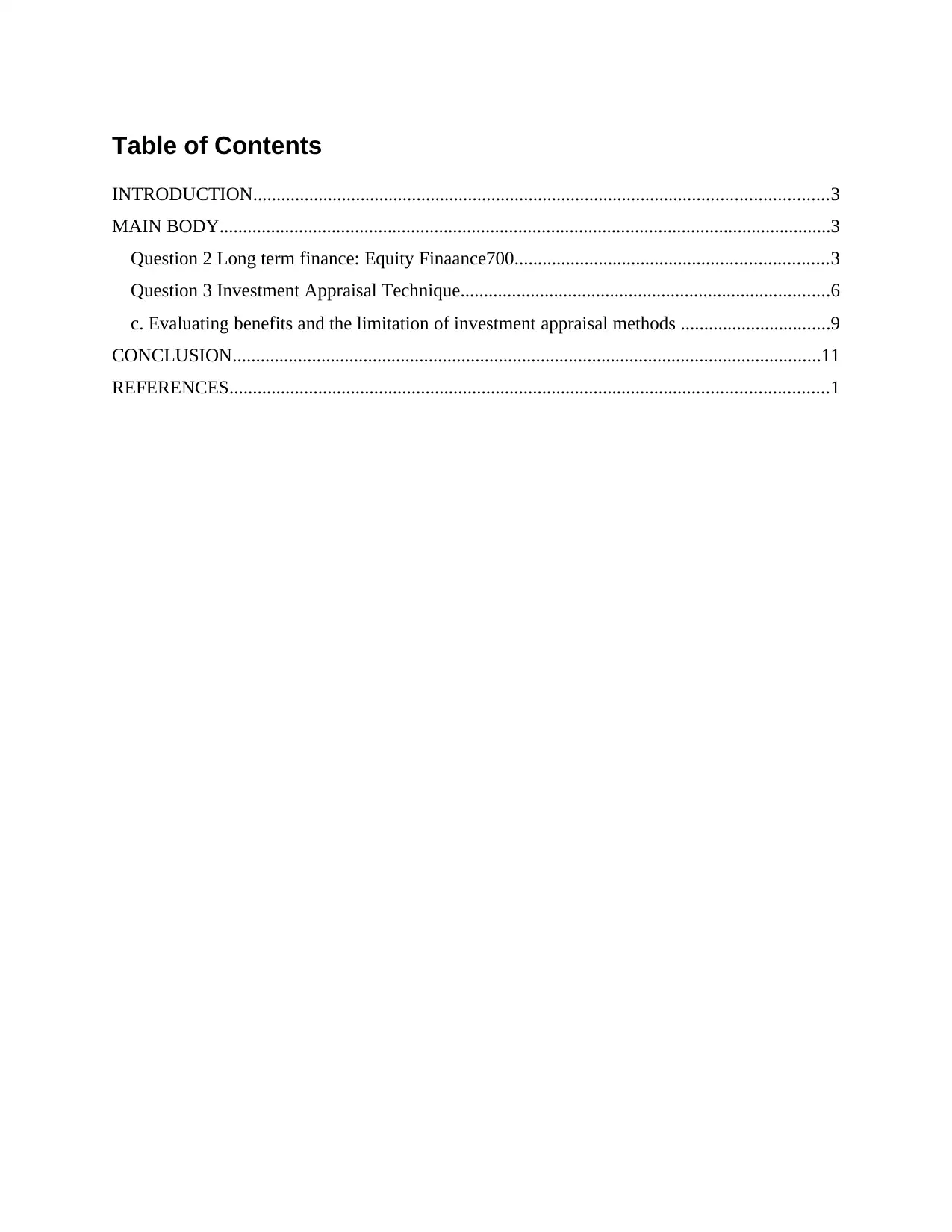
Table of Contents
INTRODUCTION...........................................................................................................................3
MAIN BODY...................................................................................................................................3
Question 2 Long term finance: Equity Finaance700...................................................................3
Question 3 Investment Appraisal Technique...............................................................................6
c. Evaluating benefits and the limitation of investment appraisal methods ................................9
CONCLUSION..............................................................................................................................11
REFERENCES................................................................................................................................1
INTRODUCTION...........................................................................................................................3
MAIN BODY...................................................................................................................................3
Question 2 Long term finance: Equity Finaance700...................................................................3
Question 3 Investment Appraisal Technique...............................................................................6
c. Evaluating benefits and the limitation of investment appraisal methods ................................9
CONCLUSION..............................................................................................................................11
REFERENCES................................................................................................................................1
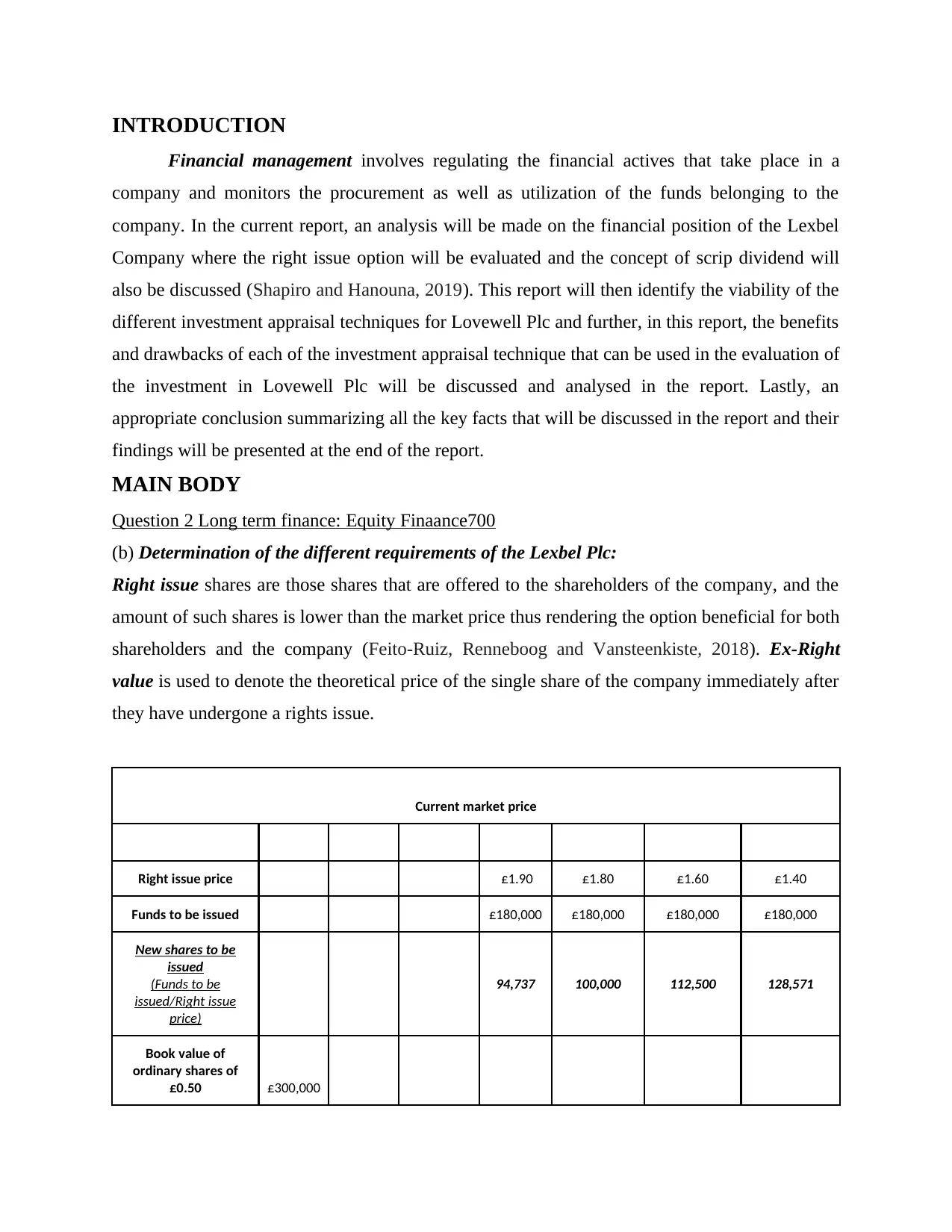
INTRODUCTION
Financial management involves regulating the financial actives that take place in a
company and monitors the procurement as well as utilization of the funds belonging to the
company. In the current report, an analysis will be made on the financial position of the Lexbel
Company where the right issue option will be evaluated and the concept of scrip dividend will
also be discussed (Shapiro and Hanouna, 2019). This report will then identify the viability of the
different investment appraisal techniques for Lovewell Plc and further, in this report, the benefits
and drawbacks of each of the investment appraisal technique that can be used in the evaluation of
the investment in Lovewell Plc will be discussed and analysed in the report. Lastly, an
appropriate conclusion summarizing all the key facts that will be discussed in the report and their
findings will be presented at the end of the report.
MAIN BODY
Question 2 Long term finance: Equity Finaance700
(b) Determination of the different requirements of the Lexbel Plc:
Right issue shares are those shares that are offered to the shareholders of the company, and the
amount of such shares is lower than the market price thus rendering the option beneficial for both
shareholders and the company (Feito-Ruiz, Renneboog and Vansteenkiste, 2018). Ex-Right
value is used to denote the theoretical price of the single share of the company immediately after
they have undergone a rights issue.
Current market price
Right issue price £1.90 £1.80 £1.60 £1.40
Funds to be issued £180,000 £180,000 £180,000 £180,000
New shares to be
issued
(Funds to be
issued/Right issue
price)
94,737 100,000 112,500 128,571
Book value of
ordinary shares of
£0.50 £300,000
Financial management involves regulating the financial actives that take place in a
company and monitors the procurement as well as utilization of the funds belonging to the
company. In the current report, an analysis will be made on the financial position of the Lexbel
Company where the right issue option will be evaluated and the concept of scrip dividend will
also be discussed (Shapiro and Hanouna, 2019). This report will then identify the viability of the
different investment appraisal techniques for Lovewell Plc and further, in this report, the benefits
and drawbacks of each of the investment appraisal technique that can be used in the evaluation of
the investment in Lovewell Plc will be discussed and analysed in the report. Lastly, an
appropriate conclusion summarizing all the key facts that will be discussed in the report and their
findings will be presented at the end of the report.
MAIN BODY
Question 2 Long term finance: Equity Finaance700
(b) Determination of the different requirements of the Lexbel Plc:
Right issue shares are those shares that are offered to the shareholders of the company, and the
amount of such shares is lower than the market price thus rendering the option beneficial for both
shareholders and the company (Feito-Ruiz, Renneboog and Vansteenkiste, 2018). Ex-Right
value is used to denote the theoretical price of the single share of the company immediately after
they have undergone a rights issue.
Current market price
Right issue price £1.90 £1.80 £1.60 £1.40
Funds to be issued £180,000 £180,000 £180,000 £180,000
New shares to be
issued
(Funds to be
issued/Right issue
price)
94,737 100,000 112,500 128,571
Book value of
ordinary shares of
£0.50 £300,000
⊘ This is a preview!⊘
Do you want full access?
Subscribe today to unlock all pages.

Trusted by 1+ million students worldwide

Numbers of shares
(Ordinary
shares/price)
600,000
Current market value
of the shares
(Number of
shares*Current
market price) £1,140,000
Funds raised through
right issus £180,000
Final value market
(Current market +
Funds to be issued)
£1,320,000
Total new shares after
right issue (
New shares
issued+Number of
shares) 694,737 700,000 712,500 728,571
Reserves shares £400,000
Total value of the
company
(Book value of
shares+rezerved) £700,000
Profit after tax (PAT)
(Value of the
company*20%) £140,000
Earning from new
funds (20%)
(Funds to be
issue*20%) £36,000
Total earnings after
right issue £176,000
Theoretical ex-right
price (TERP)
(Final value
market/Total new
shares after right
issue) 1.90 1.89 1.85 1.81
New earning per
shares
(Total earning after
0.25(25p) 0.25(25p) 0.25(25p) 0.24(24p)
(Ordinary
shares/price)
600,000
Current market value
of the shares
(Number of
shares*Current
market price) £1,140,000
Funds raised through
right issus £180,000
Final value market
(Current market +
Funds to be issued)
£1,320,000
Total new shares after
right issue (
New shares
issued+Number of
shares) 694,737 700,000 712,500 728,571
Reserves shares £400,000
Total value of the
company
(Book value of
shares+rezerved) £700,000
Profit after tax (PAT)
(Value of the
company*20%) £140,000
Earning from new
funds (20%)
(Funds to be
issue*20%) £36,000
Total earnings after
right issue £176,000
Theoretical ex-right
price (TERP)
(Final value
market/Total new
shares after right
issue) 1.90 1.89 1.85 1.81
New earning per
shares
(Total earning after
0.25(25p) 0.25(25p) 0.25(25p) 0.24(24p)
Paraphrase This Document
Need a fresh take? Get an instant paraphrase of this document with our AI Paraphraser
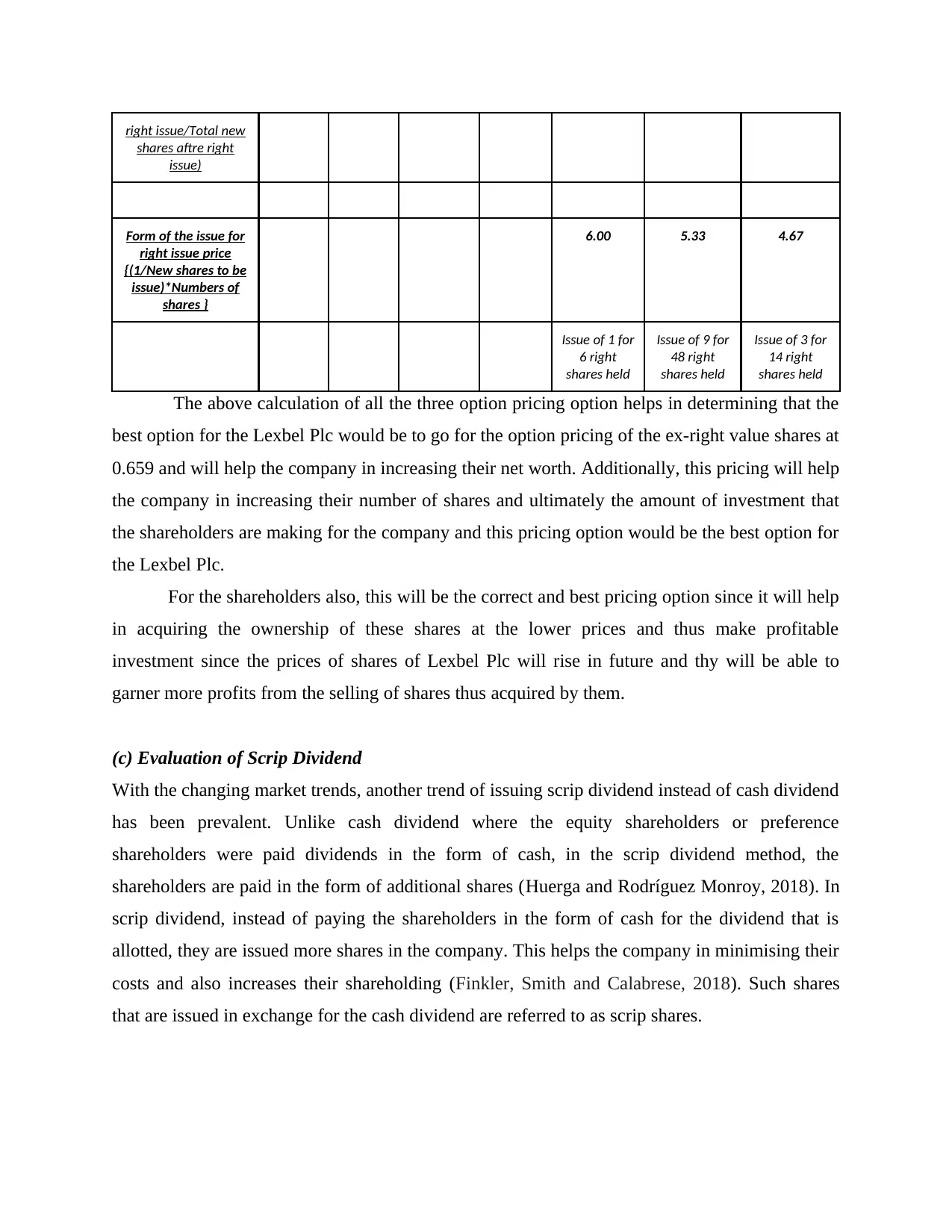
right issue/Total new
shares aftre right
issue)
Form of the issue for
right issue price
{(1/New shares to be
issue)*Numbers of
shares }
6.00 5.33 4.67
Issue of 1 for
6 right
shares held
Issue of 9 for
48 right
shares held
Issue of 3 for
14 right
shares held
The above calculation of all the three option pricing option helps in determining that the
best option for the Lexbel Plc would be to go for the option pricing of the ex-right value shares at
0.659 and will help the company in increasing their net worth. Additionally, this pricing will help
the company in increasing their number of shares and ultimately the amount of investment that
the shareholders are making for the company and this pricing option would be the best option for
the Lexbel Plc.
For the shareholders also, this will be the correct and best pricing option since it will help
in acquiring the ownership of these shares at the lower prices and thus make profitable
investment since the prices of shares of Lexbel Plc will rise in future and thy will be able to
garner more profits from the selling of shares thus acquired by them.
(c) Evaluation of Scrip Dividend
With the changing market trends, another trend of issuing scrip dividend instead of cash dividend
has been prevalent. Unlike cash dividend where the equity shareholders or preference
shareholders were paid dividends in the form of cash, in the scrip dividend method, the
shareholders are paid in the form of additional shares (Huerga and Rodríguez Monroy, 2018). In
scrip dividend, instead of paying the shareholders in the form of cash for the dividend that is
allotted, they are issued more shares in the company. This helps the company in minimising their
costs and also increases their shareholding (Finkler, Smith and Calabrese, 2018). Such shares
that are issued in exchange for the cash dividend are referred to as scrip shares.
shares aftre right
issue)
Form of the issue for
right issue price
{(1/New shares to be
issue)*Numbers of
shares }
6.00 5.33 4.67
Issue of 1 for
6 right
shares held
Issue of 9 for
48 right
shares held
Issue of 3 for
14 right
shares held
The above calculation of all the three option pricing option helps in determining that the
best option for the Lexbel Plc would be to go for the option pricing of the ex-right value shares at
0.659 and will help the company in increasing their net worth. Additionally, this pricing will help
the company in increasing their number of shares and ultimately the amount of investment that
the shareholders are making for the company and this pricing option would be the best option for
the Lexbel Plc.
For the shareholders also, this will be the correct and best pricing option since it will help
in acquiring the ownership of these shares at the lower prices and thus make profitable
investment since the prices of shares of Lexbel Plc will rise in future and thy will be able to
garner more profits from the selling of shares thus acquired by them.
(c) Evaluation of Scrip Dividend
With the changing market trends, another trend of issuing scrip dividend instead of cash dividend
has been prevalent. Unlike cash dividend where the equity shareholders or preference
shareholders were paid dividends in the form of cash, in the scrip dividend method, the
shareholders are paid in the form of additional shares (Huerga and Rodríguez Monroy, 2018). In
scrip dividend, instead of paying the shareholders in the form of cash for the dividend that is
allotted, they are issued more shares in the company. This helps the company in minimising their
costs and also increases their shareholding (Finkler, Smith and Calabrese, 2018). Such shares
that are issued in exchange for the cash dividend are referred to as scrip shares.
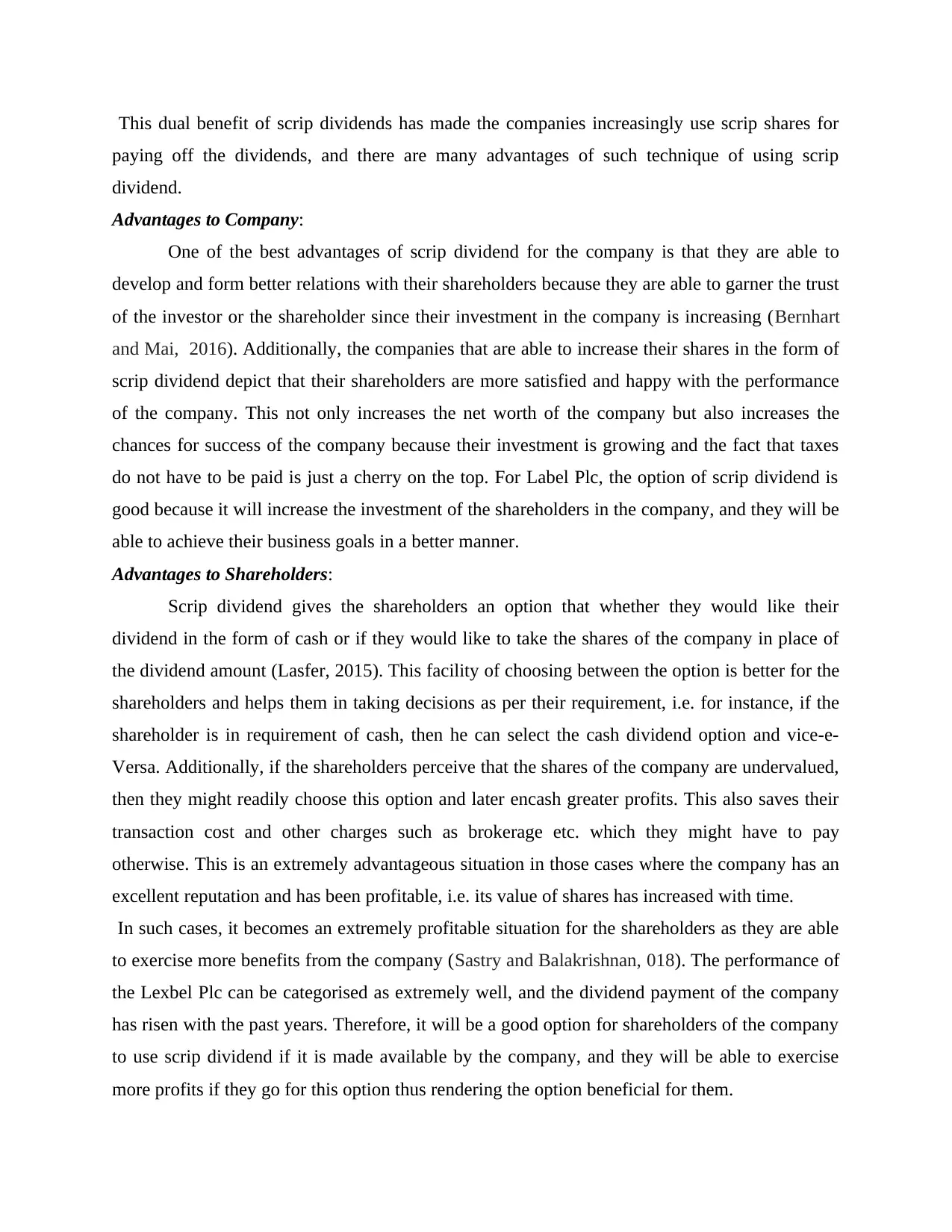
This dual benefit of scrip dividends has made the companies increasingly use scrip shares for
paying off the dividends, and there are many advantages of such technique of using scrip
dividend.
Advantages to Company:
One of the best advantages of scrip dividend for the company is that they are able to
develop and form better relations with their shareholders because they are able to garner the trust
of the investor or the shareholder since their investment in the company is increasing (Bernhart
and Mai, 2016). Additionally, the companies that are able to increase their shares in the form of
scrip dividend depict that their shareholders are more satisfied and happy with the performance
of the company. This not only increases the net worth of the company but also increases the
chances for success of the company because their investment is growing and the fact that taxes
do not have to be paid is just a cherry on the top. For Label Plc, the option of scrip dividend is
good because it will increase the investment of the shareholders in the company, and they will be
able to achieve their business goals in a better manner.
Advantages to Shareholders:
Scrip dividend gives the shareholders an option that whether they would like their
dividend in the form of cash or if they would like to take the shares of the company in place of
the dividend amount (Lasfer, 2015). This facility of choosing between the option is better for the
shareholders and helps them in taking decisions as per their requirement, i.e. for instance, if the
shareholder is in requirement of cash, then he can select the cash dividend option and vice-e-
Versa. Additionally, if the shareholders perceive that the shares of the company are undervalued,
then they might readily choose this option and later encash greater profits. This also saves their
transaction cost and other charges such as brokerage etc. which they might have to pay
otherwise. This is an extremely advantageous situation in those cases where the company has an
excellent reputation and has been profitable, i.e. its value of shares has increased with time.
In such cases, it becomes an extremely profitable situation for the shareholders as they are able
to exercise more benefits from the company (Sastry and Balakrishnan, 018). The performance of
the Lexbel Plc can be categorised as extremely well, and the dividend payment of the company
has risen with the past years. Therefore, it will be a good option for shareholders of the company
to use scrip dividend if it is made available by the company, and they will be able to exercise
more profits if they go for this option thus rendering the option beneficial for them.
paying off the dividends, and there are many advantages of such technique of using scrip
dividend.
Advantages to Company:
One of the best advantages of scrip dividend for the company is that they are able to
develop and form better relations with their shareholders because they are able to garner the trust
of the investor or the shareholder since their investment in the company is increasing (Bernhart
and Mai, 2016). Additionally, the companies that are able to increase their shares in the form of
scrip dividend depict that their shareholders are more satisfied and happy with the performance
of the company. This not only increases the net worth of the company but also increases the
chances for success of the company because their investment is growing and the fact that taxes
do not have to be paid is just a cherry on the top. For Label Plc, the option of scrip dividend is
good because it will increase the investment of the shareholders in the company, and they will be
able to achieve their business goals in a better manner.
Advantages to Shareholders:
Scrip dividend gives the shareholders an option that whether they would like their
dividend in the form of cash or if they would like to take the shares of the company in place of
the dividend amount (Lasfer, 2015). This facility of choosing between the option is better for the
shareholders and helps them in taking decisions as per their requirement, i.e. for instance, if the
shareholder is in requirement of cash, then he can select the cash dividend option and vice-e-
Versa. Additionally, if the shareholders perceive that the shares of the company are undervalued,
then they might readily choose this option and later encash greater profits. This also saves their
transaction cost and other charges such as brokerage etc. which they might have to pay
otherwise. This is an extremely advantageous situation in those cases where the company has an
excellent reputation and has been profitable, i.e. its value of shares has increased with time.
In such cases, it becomes an extremely profitable situation for the shareholders as they are able
to exercise more benefits from the company (Sastry and Balakrishnan, 018). The performance of
the Lexbel Plc can be categorised as extremely well, and the dividend payment of the company
has risen with the past years. Therefore, it will be a good option for shareholders of the company
to use scrip dividend if it is made available by the company, and they will be able to exercise
more profits if they go for this option thus rendering the option beneficial for them.
⊘ This is a preview!⊘
Do you want full access?
Subscribe today to unlock all pages.

Trusted by 1+ million students worldwide
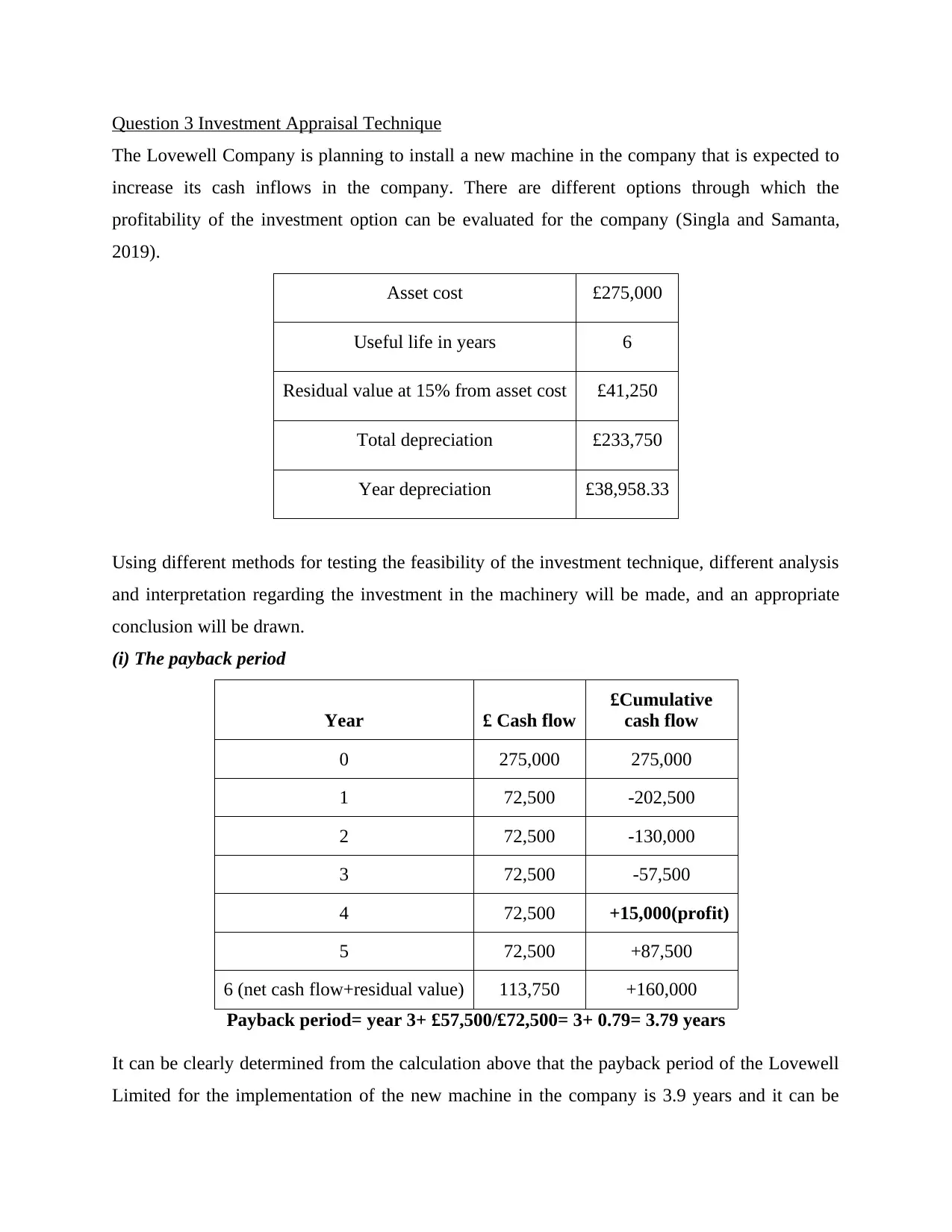
Question 3 Investment Appraisal Technique
The Lovewell Company is planning to install a new machine in the company that is expected to
increase its cash inflows in the company. There are different options through which the
profitability of the investment option can be evaluated for the company (Singla and Samanta,
2019).
Asset cost £275,000
Useful life in years 6
Residual value at 15% from asset cost £41,250
Total depreciation £233,750
Year depreciation £38,958.33
Using different methods for testing the feasibility of the investment technique, different analysis
and interpretation regarding the investment in the machinery will be made, and an appropriate
conclusion will be drawn.
(i) The payback period
Year £ Cash flow
£Cumulative
cash flow
0 275,000 275,000
1 72,500 -202,500
2 72,500 -130,000
3 72,500 -57,500
4 72,500 +15,000(profit)
5 72,500 +87,500
6 (net cash flow+residual value) 113,750 +160,000
Payback period= year 3+ £57,500/£72,500= 3+ 0.79= 3.79 years
It can be clearly determined from the calculation above that the payback period of the Lovewell
Limited for the implementation of the new machine in the company is 3.9 years and it can be
The Lovewell Company is planning to install a new machine in the company that is expected to
increase its cash inflows in the company. There are different options through which the
profitability of the investment option can be evaluated for the company (Singla and Samanta,
2019).
Asset cost £275,000
Useful life in years 6
Residual value at 15% from asset cost £41,250
Total depreciation £233,750
Year depreciation £38,958.33
Using different methods for testing the feasibility of the investment technique, different analysis
and interpretation regarding the investment in the machinery will be made, and an appropriate
conclusion will be drawn.
(i) The payback period
Year £ Cash flow
£Cumulative
cash flow
0 275,000 275,000
1 72,500 -202,500
2 72,500 -130,000
3 72,500 -57,500
4 72,500 +15,000(profit)
5 72,500 +87,500
6 (net cash flow+residual value) 113,750 +160,000
Payback period= year 3+ £57,500/£72,500= 3+ 0.79= 3.79 years
It can be clearly determined from the calculation above that the payback period of the Lovewell
Limited for the implementation of the new machine in the company is 3.9 years and it can be
Paraphrase This Document
Need a fresh take? Get an instant paraphrase of this document with our AI Paraphraser
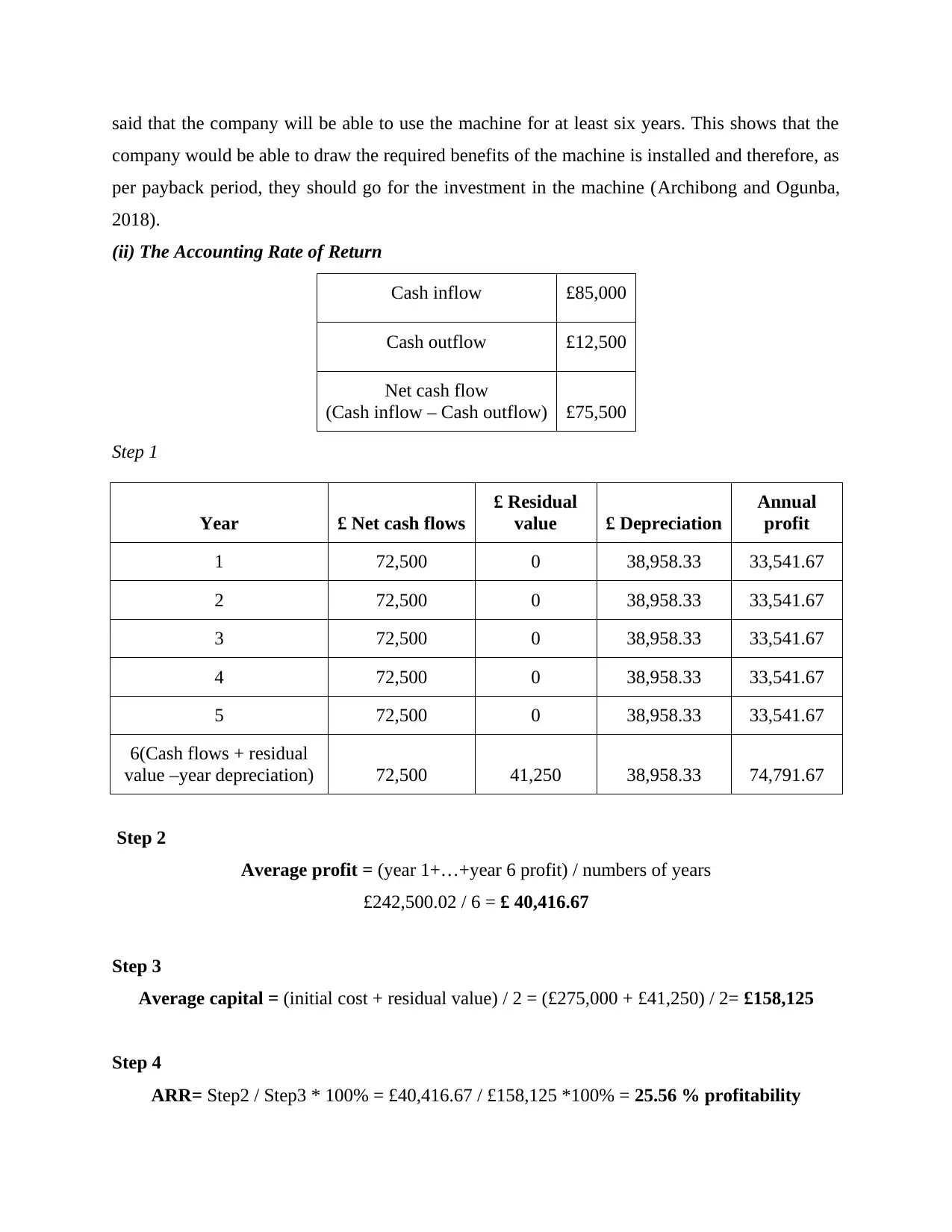
said that the company will be able to use the machine for at least six years. This shows that the
company would be able to draw the required benefits of the machine is installed and therefore, as
per payback period, they should go for the investment in the machine (Archibong and Ogunba,
2018).
(ii) The Accounting Rate of Return
Cash inflow £85,000
Cash outflow £12,500
Net cash flow
(Cash inflow – Cash outflow) £75,500
Step 1
Year £ Net cash flows
£ Residual
value £ Depreciation
Annual
profit
1 72,500 0 38,958.33 33,541.67
2 72,500 0 38,958.33 33,541.67
3 72,500 0 38,958.33 33,541.67
4 72,500 0 38,958.33 33,541.67
5 72,500 0 38,958.33 33,541.67
6(Cash flows + residual
value –year depreciation) 72,500 41,250 38,958.33 74,791.67
Step 2
Average profit = (year 1+…+year 6 profit) / numbers of years
£242,500.02 / 6 = £ 40,416.67
Step 3
Average capital = (initial cost + residual value) / 2 = (£275,000 + £41,250) / 2= £158,125
Step 4
ARR= Step2 / Step3 * 100% = £40,416.67 / £158,125 *100% = 25.56 % profitability
company would be able to draw the required benefits of the machine is installed and therefore, as
per payback period, they should go for the investment in the machine (Archibong and Ogunba,
2018).
(ii) The Accounting Rate of Return
Cash inflow £85,000
Cash outflow £12,500
Net cash flow
(Cash inflow – Cash outflow) £75,500
Step 1
Year £ Net cash flows
£ Residual
value £ Depreciation
Annual
profit
1 72,500 0 38,958.33 33,541.67
2 72,500 0 38,958.33 33,541.67
3 72,500 0 38,958.33 33,541.67
4 72,500 0 38,958.33 33,541.67
5 72,500 0 38,958.33 33,541.67
6(Cash flows + residual
value –year depreciation) 72,500 41,250 38,958.33 74,791.67
Step 2
Average profit = (year 1+…+year 6 profit) / numbers of years
£242,500.02 / 6 = £ 40,416.67
Step 3
Average capital = (initial cost + residual value) / 2 = (£275,000 + £41,250) / 2= £158,125
Step 4
ARR= Step2 / Step3 * 100% = £40,416.67 / £158,125 *100% = 25.56 % profitability
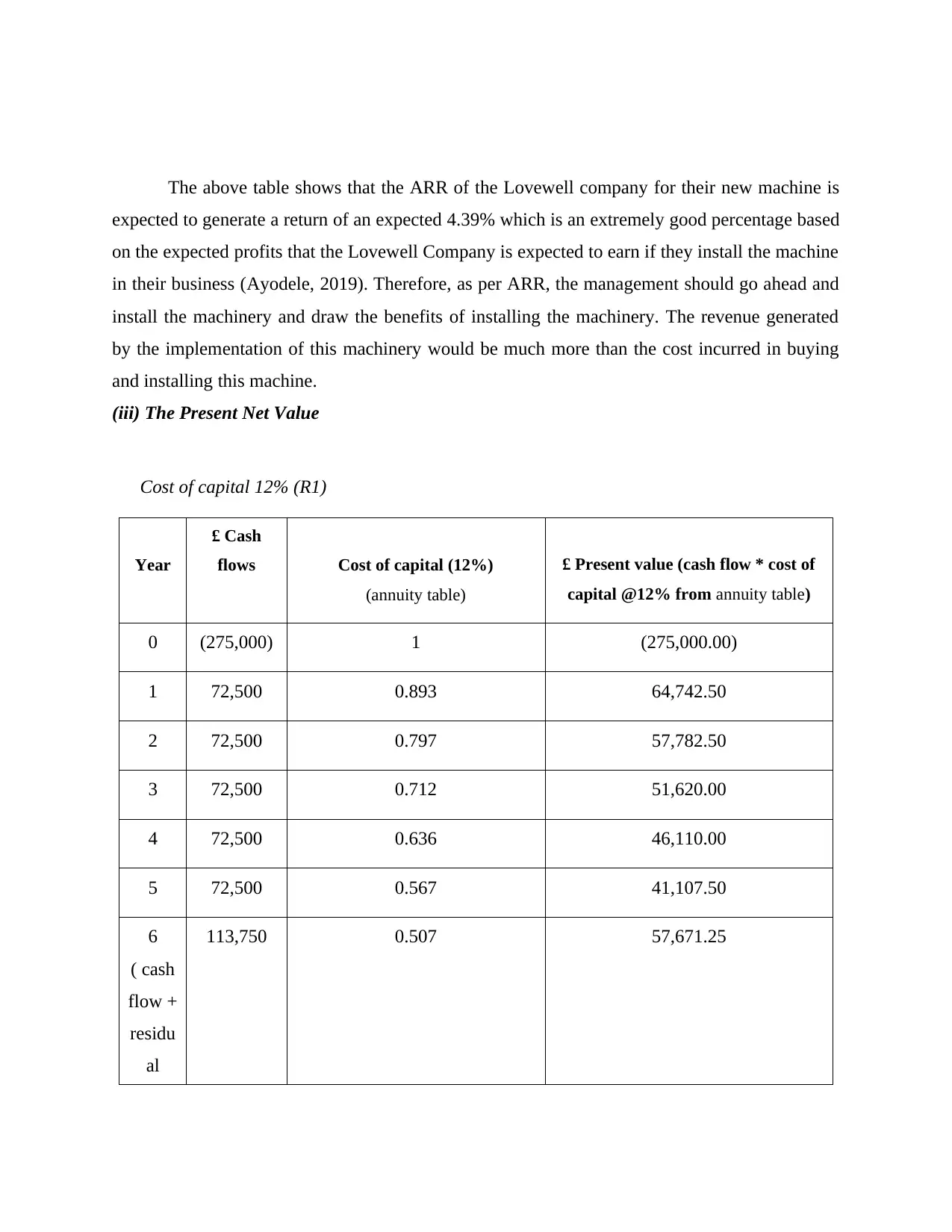
The above table shows that the ARR of the Lovewell company for their new machine is
expected to generate a return of an expected 4.39% which is an extremely good percentage based
on the expected profits that the Lovewell Company is expected to earn if they install the machine
in their business (Ayodele, 2019). Therefore, as per ARR, the management should go ahead and
install the machinery and draw the benefits of installing the machinery. The revenue generated
by the implementation of this machinery would be much more than the cost incurred in buying
and installing this machine.
(iii) The Present Net Value
Cost of capital 12% (R1)
Year
£ Cash
flows Cost of capital (12%)
(annuity table)
£ Present value (cash flow * cost of
capital @12% from annuity table)
0 (275,000) 1 (275,000.00)
1 72,500 0.893 64,742.50
2 72,500 0.797 57,782.50
3 72,500 0.712 51,620.00
4 72,500 0.636 46,110.00
5 72,500 0.567 41,107.50
6
( cash
flow +
residu
al
113,750 0.507 57,671.25
expected to generate a return of an expected 4.39% which is an extremely good percentage based
on the expected profits that the Lovewell Company is expected to earn if they install the machine
in their business (Ayodele, 2019). Therefore, as per ARR, the management should go ahead and
install the machinery and draw the benefits of installing the machinery. The revenue generated
by the implementation of this machinery would be much more than the cost incurred in buying
and installing this machine.
(iii) The Present Net Value
Cost of capital 12% (R1)
Year
£ Cash
flows Cost of capital (12%)
(annuity table)
£ Present value (cash flow * cost of
capital @12% from annuity table)
0 (275,000) 1 (275,000.00)
1 72,500 0.893 64,742.50
2 72,500 0.797 57,782.50
3 72,500 0.712 51,620.00
4 72,500 0.636 46,110.00
5 72,500 0.567 41,107.50
6
( cash
flow +
residu
al
113,750 0.507 57,671.25
⊘ This is a preview!⊘
Do you want full access?
Subscribe today to unlock all pages.

Trusted by 1+ million students worldwide
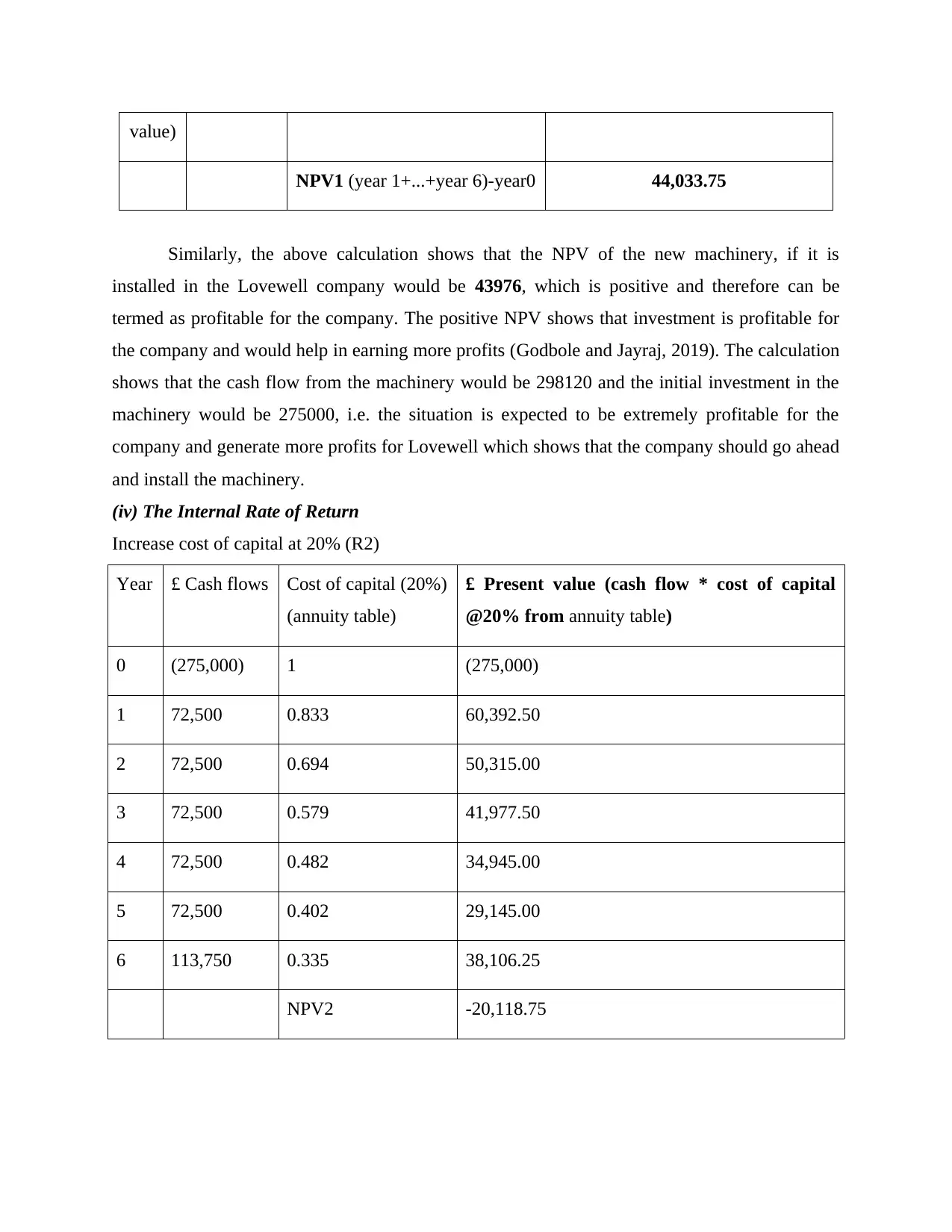
value)
NPV1 (year 1+...+year 6)-year0 44,033.75
Similarly, the above calculation shows that the NPV of the new machinery, if it is
installed in the Lovewell company would be 43976, which is positive and therefore can be
termed as profitable for the company. The positive NPV shows that investment is profitable for
the company and would help in earning more profits (Godbole and Jayraj, 2019). The calculation
shows that the cash flow from the machinery would be 298120 and the initial investment in the
machinery would be 275000, i.e. the situation is expected to be extremely profitable for the
company and generate more profits for Lovewell which shows that the company should go ahead
and install the machinery.
(iv) The Internal Rate of Return
Increase cost of capital at 20% (R2)
Year £ Cash flows Cost of capital (20%)
(annuity table)
£ Present value (cash flow * cost of capital
@20% from annuity table)
0 (275,000) 1 (275,000)
1 72,500 0.833 60,392.50
2 72,500 0.694 50,315.00
3 72,500 0.579 41,977.50
4 72,500 0.482 34,945.00
5 72,500 0.402 29,145.00
6 113,750 0.335 38,106.25
NPV2 -20,118.75
NPV1 (year 1+...+year 6)-year0 44,033.75
Similarly, the above calculation shows that the NPV of the new machinery, if it is
installed in the Lovewell company would be 43976, which is positive and therefore can be
termed as profitable for the company. The positive NPV shows that investment is profitable for
the company and would help in earning more profits (Godbole and Jayraj, 2019). The calculation
shows that the cash flow from the machinery would be 298120 and the initial investment in the
machinery would be 275000, i.e. the situation is expected to be extremely profitable for the
company and generate more profits for Lovewell which shows that the company should go ahead
and install the machinery.
(iv) The Internal Rate of Return
Increase cost of capital at 20% (R2)
Year £ Cash flows Cost of capital (20%)
(annuity table)
£ Present value (cash flow * cost of capital
@20% from annuity table)
0 (275,000) 1 (275,000)
1 72,500 0.833 60,392.50
2 72,500 0.694 50,315.00
3 72,500 0.579 41,977.50
4 72,500 0.482 34,945.00
5 72,500 0.402 29,145.00
6 113,750 0.335 38,106.25
NPV2 -20,118.75
Paraphrase This Document
Need a fresh take? Get an instant paraphrase of this document with our AI Paraphraser
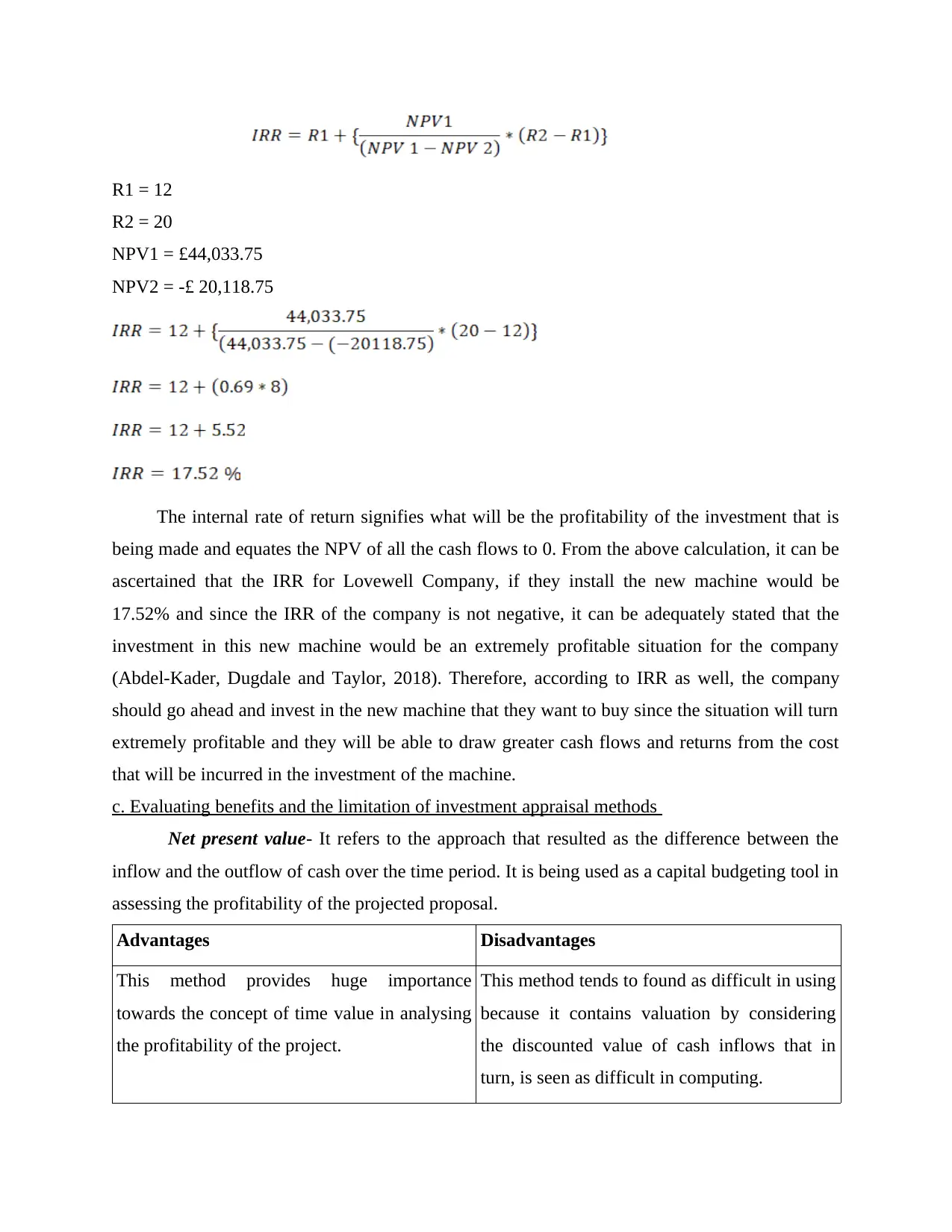
R1 = 12
R2 = 20
NPV1 = £44,033.75
NPV2 = -£ 20,118.75
The internal rate of return signifies what will be the profitability of the investment that is
being made and equates the NPV of all the cash flows to 0. From the above calculation, it can be
ascertained that the IRR for Lovewell Company, if they install the new machine would be
17.52% and since the IRR of the company is not negative, it can be adequately stated that the
investment in this new machine would be an extremely profitable situation for the company
(Abdel-Kader, Dugdale and Taylor, 2018). Therefore, according to IRR as well, the company
should go ahead and invest in the new machine that they want to buy since the situation will turn
extremely profitable and they will be able to draw greater cash flows and returns from the cost
that will be incurred in the investment of the machine.
c. Evaluating benefits and the limitation of investment appraisal methods
Net present value- It refers to the approach that resulted as the difference between the
inflow and the outflow of cash over the time period. It is being used as a capital budgeting tool in
assessing the profitability of the projected proposal.
Advantages Disadvantages
This method provides huge importance
towards the concept of time value in analysing
the profitability of the project.
This method tends to found as difficult in using
because it contains valuation by considering
the discounted value of cash inflows that in
turn, is seen as difficult in computing.
R2 = 20
NPV1 = £44,033.75
NPV2 = -£ 20,118.75
The internal rate of return signifies what will be the profitability of the investment that is
being made and equates the NPV of all the cash flows to 0. From the above calculation, it can be
ascertained that the IRR for Lovewell Company, if they install the new machine would be
17.52% and since the IRR of the company is not negative, it can be adequately stated that the
investment in this new machine would be an extremely profitable situation for the company
(Abdel-Kader, Dugdale and Taylor, 2018). Therefore, according to IRR as well, the company
should go ahead and invest in the new machine that they want to buy since the situation will turn
extremely profitable and they will be able to draw greater cash flows and returns from the cost
that will be incurred in the investment of the machine.
c. Evaluating benefits and the limitation of investment appraisal methods
Net present value- It refers to the approach that resulted as the difference between the
inflow and the outflow of cash over the time period. It is being used as a capital budgeting tool in
assessing the profitability of the projected proposal.
Advantages Disadvantages
This method provides huge importance
towards the concept of time value in analysing
the profitability of the project.
This method tends to found as difficult in using
because it contains valuation by considering
the discounted value of cash inflows that in
turn, is seen as difficult in computing.
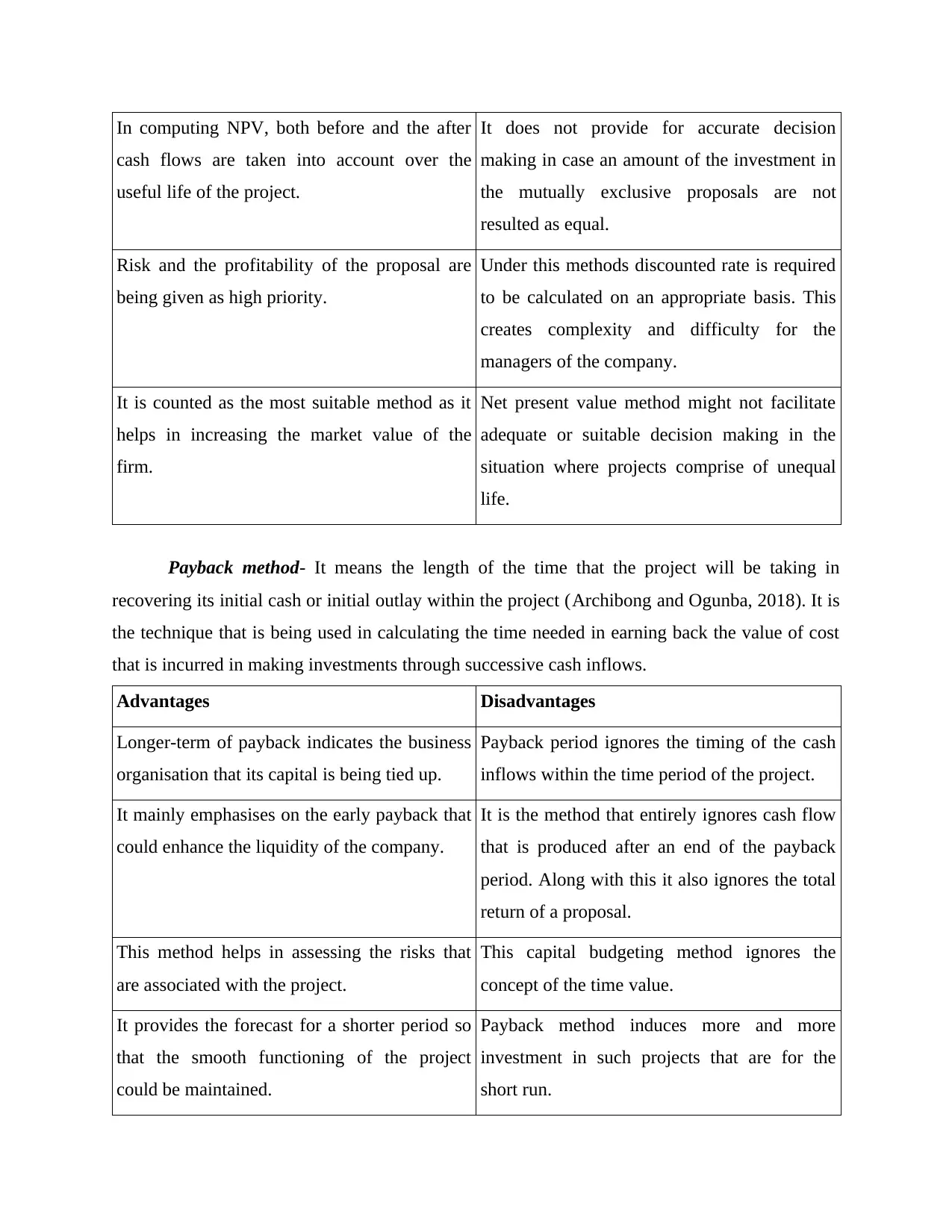
In computing NPV, both before and the after
cash flows are taken into account over the
useful life of the project.
It does not provide for accurate decision
making in case an amount of the investment in
the mutually exclusive proposals are not
resulted as equal.
Risk and the profitability of the proposal are
being given as high priority.
Under this methods discounted rate is required
to be calculated on an appropriate basis. This
creates complexity and difficulty for the
managers of the company.
It is counted as the most suitable method as it
helps in increasing the market value of the
firm.
Net present value method might not facilitate
adequate or suitable decision making in the
situation where projects comprise of unequal
life.
Payback method- It means the length of the time that the project will be taking in
recovering its initial cash or initial outlay within the project (Archibong and Ogunba, 2018). It is
the technique that is being used in calculating the time needed in earning back the value of cost
that is incurred in making investments through successive cash inflows.
Advantages Disadvantages
Longer-term of payback indicates the business
organisation that its capital is being tied up.
Payback period ignores the timing of the cash
inflows within the time period of the project.
It mainly emphasises on the early payback that
could enhance the liquidity of the company.
It is the method that entirely ignores cash flow
that is produced after an end of the payback
period. Along with this it also ignores the total
return of a proposal.
This method helps in assessing the risks that
are associated with the project.
This capital budgeting method ignores the
concept of the time value.
It provides the forecast for a shorter period so
that the smooth functioning of the project
could be maintained.
Payback method induces more and more
investment in such projects that are for the
short run.
cash flows are taken into account over the
useful life of the project.
It does not provide for accurate decision
making in case an amount of the investment in
the mutually exclusive proposals are not
resulted as equal.
Risk and the profitability of the proposal are
being given as high priority.
Under this methods discounted rate is required
to be calculated on an appropriate basis. This
creates complexity and difficulty for the
managers of the company.
It is counted as the most suitable method as it
helps in increasing the market value of the
firm.
Net present value method might not facilitate
adequate or suitable decision making in the
situation where projects comprise of unequal
life.
Payback method- It means the length of the time that the project will be taking in
recovering its initial cash or initial outlay within the project (Archibong and Ogunba, 2018). It is
the technique that is being used in calculating the time needed in earning back the value of cost
that is incurred in making investments through successive cash inflows.
Advantages Disadvantages
Longer-term of payback indicates the business
organisation that its capital is being tied up.
Payback period ignores the timing of the cash
inflows within the time period of the project.
It mainly emphasises on the early payback that
could enhance the liquidity of the company.
It is the method that entirely ignores cash flow
that is produced after an end of the payback
period. Along with this it also ignores the total
return of a proposal.
This method helps in assessing the risks that
are associated with the project.
This capital budgeting method ignores the
concept of the time value.
It provides the forecast for a shorter period so
that the smooth functioning of the project
could be maintained.
Payback method induces more and more
investment in such projects that are for the
short run.
⊘ This is a preview!⊘
Do you want full access?
Subscribe today to unlock all pages.

Trusted by 1+ million students worldwide
1 out of 16